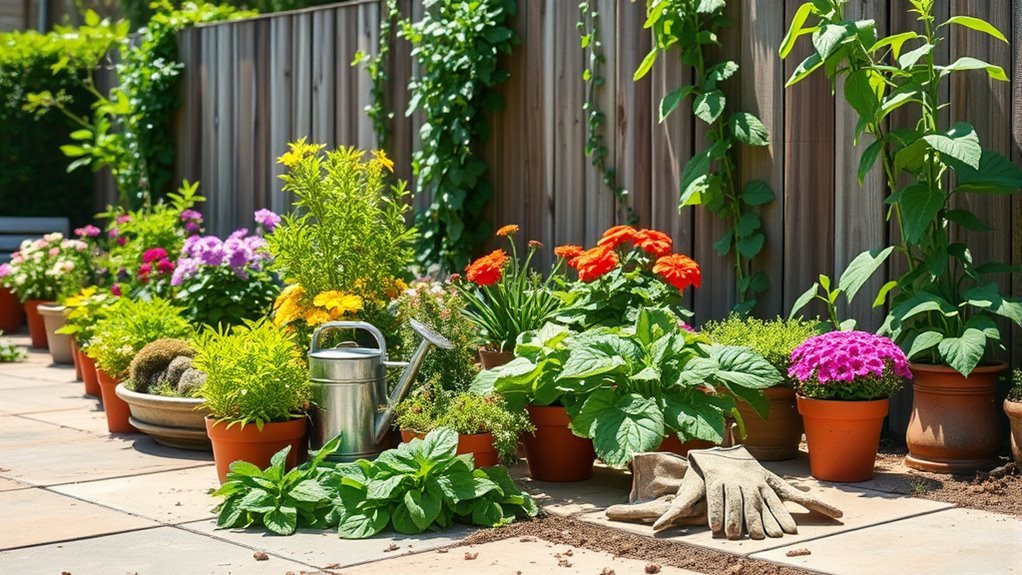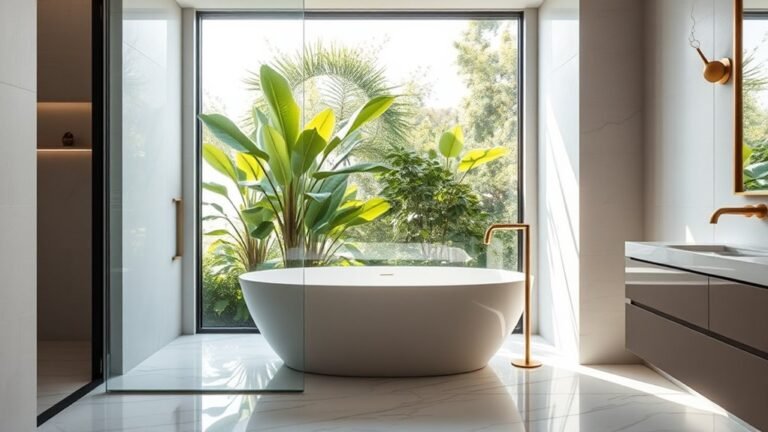40 Easy Beginner Gardening Ideas for New Plant Lovers
Start your gardening journey with easy-to-grow herbs like basil and mint. Create a container garden to brighten small spaces or try raised beds for vegetables. Vertical gardening maximizes your area with stunning wall displays. Use native plants to support local wildlife and apply mulch for effective weed control. Explore plant propagation and design seasonal flower beds for visual appeal. There’s plenty more to discover that can make gardening enjoyable and rewarding!
Start With Easy-To-Grow Herbs

Herbs are the perfect starting point for beginner gardeners looking to cultivate their green thumbs. You’ll love the herb benefits, like fresh flavors in your cooking and natural remedies for common ailments.
Start with easy herb varieties like basil, mint, and parsley—they thrive with minimal care. Growing these plants can boost your confidence and inspire you to explore more gardening. Plus, they’re often pest-resistant, making them ideal for novices.
As you nurture your herbs, you’ll learn valuable skills about plant care, watering, and sunlight requirements, laying a strong foundation for future gardening adventures. Enjoy the journey!
Create a Container Garden
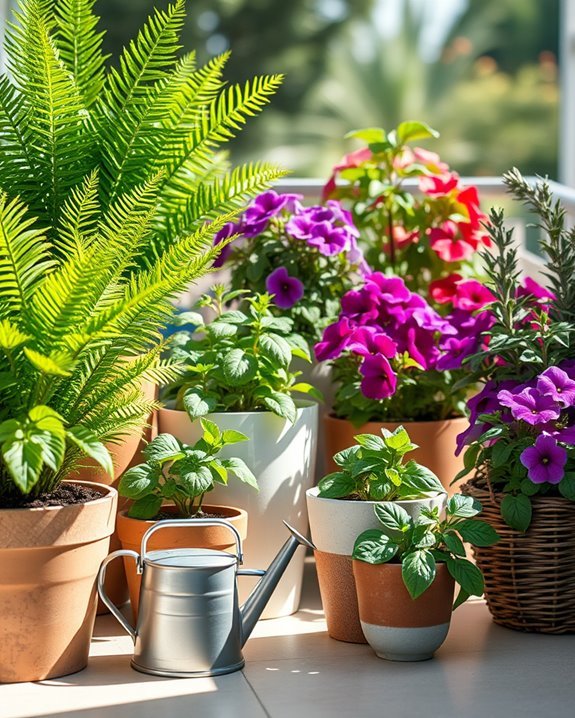
If you’re short on space or want to add a splash of greenery to your patio or balcony, creating a container garden is a fantastic option.
You can choose from various container types, such as terracotta pots, hanging baskets, or recycled containers. Each type has its own charm and functionality.
When selecting soil options, opt for potting mix specifically designed for containers, as it provides good drainage and aeration.
Don’t forget to reflect on the size of your plants and their sunlight needs.
With a little creativity, you’ll transform your small space into a vibrant oasis of color and life!
Grow Vegetables in Raised Beds

Growing vegetables in raised beds not only maximizes your gardening space but also makes tending to your plants easier on your back.
By using compost, you enhance soil health and provide essential nutrients for your crops.
Plan your garden layout carefully to incorporate crop rotation, which helps manage pests and diseases.
Employ efficient watering techniques to keep your plants thriving, and consider seasonal planting to make the most of your space.
Be mindful of plant spacing to prevent overcrowding, ensuring each vegetable has room to grow.
With these tips, you’ll enjoy a productive and rewarding gardening experience!
Try Vertical Gardening

For gardeners with limited space, vertical gardening offers an innovative way to expand your growing area.
By using vertical planters, you can create stunning wall gardens that maximize your space while adding beauty to your home. Choose a sunny wall or fence to set up your planters, and fill them with herbs, flowers, or even small vegetables.
You’ll not only save ground space but also make caring for your plants easier. With the right vertical design, you can enjoy a lush garden without sacrificing precious square footage.
Start experimenting, and watch your vertical garden flourish!
Use Native Plants
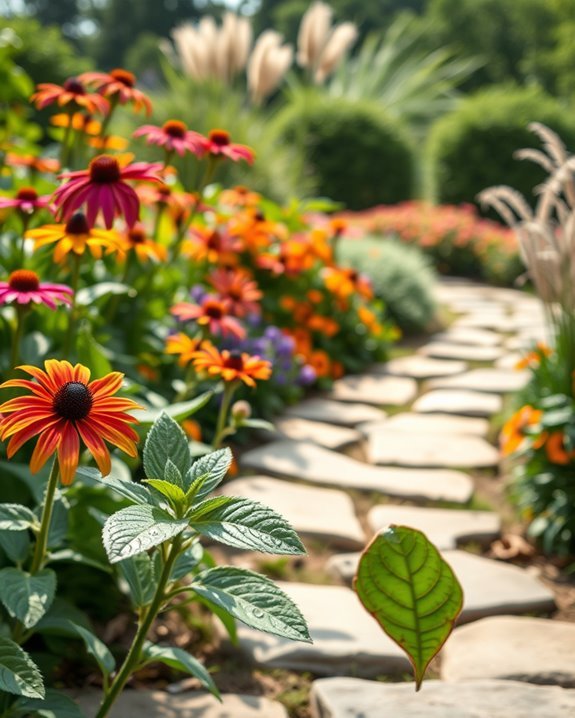
Using native plants in your garden not only supports local wildlife but also simplifies your gardening efforts.
Native plants are adapted to your region’s climate, requiring less water and fewer chemicals, which means less maintenance for you. By choosing these plants, you enhance local biodiversity, attracting pollinators like bees and butterflies.
Plus, native plants provide essential habitats for various creatures, promoting a thriving ecosystem. You’ll find that they often thrive with minimal intervention, allowing you to enjoy a beautiful garden without the stress.
Start With Flowering Annuals
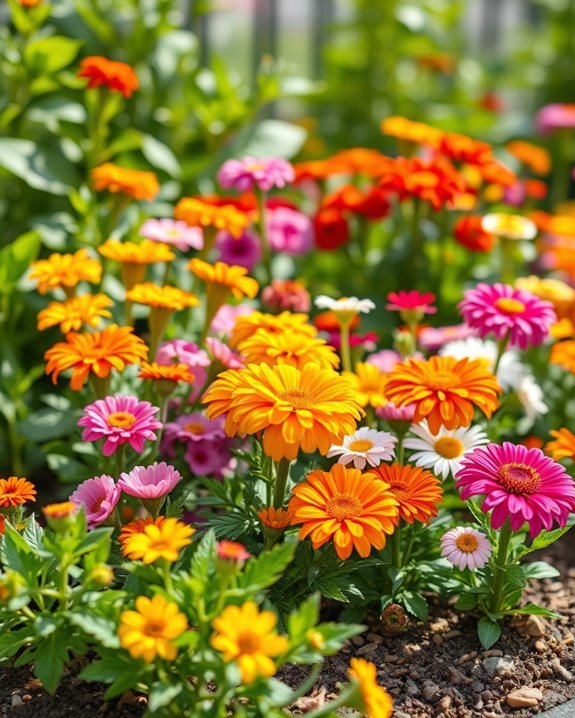
After embracing the benefits of native plants, you might want to add a splash of color to your garden with flowering annuals.
These vibrant flowering plants offer stunning seasonal blooms that can brighten up any space. Choose varieties like marigolds, petunias, or zinnias to create a lively atmosphere.
They’re easy to grow, making them perfect for beginners. Plant them in well-drained soil and guarantee they receive plenty of sunlight.
Water regularly, and you’ll enjoy a continuous display of color throughout the growing season.
With flowering annuals, you’ll gain confidence in your gardening skills while enhancing your outdoor oasis!
Experiment With Succulents
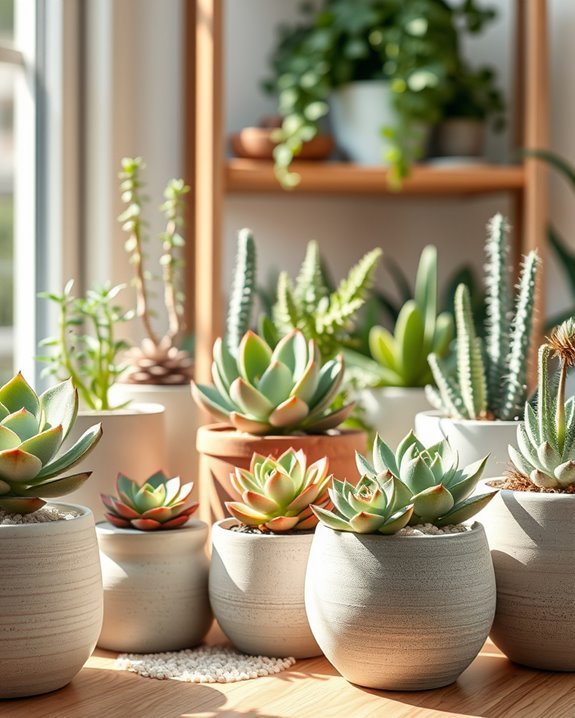
If you’re looking to add variety to your garden, experimenting with succulents can be a rewarding adventure.
These hardy plants come in countless succulent varieties, each with unique shapes and colors. They thrive in well-draining soil and prefer low soil moisture, making them perfect for beginners.
Start by choosing a few different types, like Echeveria or Aloe, and observe how they grow in different conditions. Remember to avoid overwatering, as that’s a common mistake.
With a little care, you’ll enjoy a stunning arrangement that adds character to your space while requiring minimal maintenance.
Happy gardening!
Grow Your Own Salad Greens

Adding a touch of greenery to your garden can be as simple as growing your own salad greens. You can choose from various salad varieties like lettuce, spinach, and arugula, which are all easy to grow.
These greens thrive in cooler weather and can be sown directly in your garden or containers. Not only do they add freshness to your meals, but they also offer impressive nutrient benefits.
Packed with vitamins A, C, and K, salad greens help boost your immune system and support overall health. Start small, and soon you’ll enjoy fresh, homegrown salads right from your garden!
Plant a Butterfly Garden
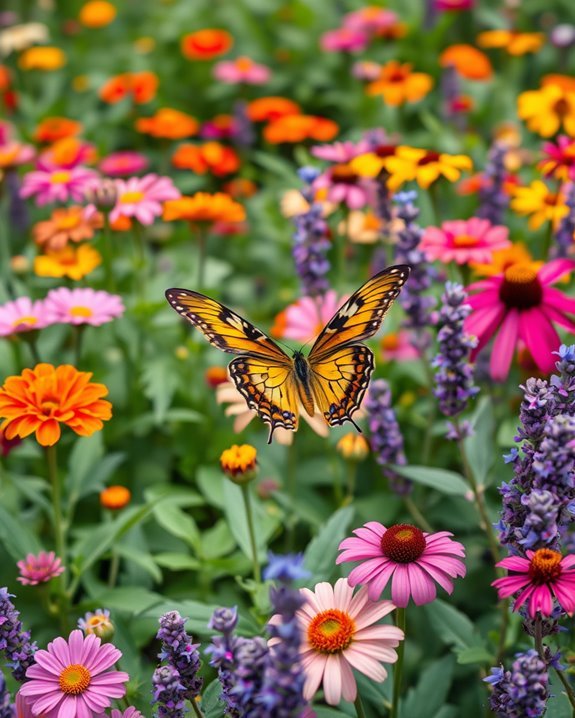
Creating a butterfly garden can be a delightful way to attract these beautiful creatures to your outdoor space.
Start by researching local butterfly species to understand which ones visit your area. Plant a variety of nectar plants, like coneflowers, milkweed, and butterfly bushes, to provide food for the butterflies.
Make sure to include host plants where butterflies can lay their eggs, ensuring a thriving garden. Choose a sunny spot with shelter from wind, and keep the soil moist.
By nurturing a butterfly garden, you’ll create a vibrant ecosystem while enjoying the enchanting sight of fluttering wings.
Happy gardening!
Make a Pollinator-Friendly Space
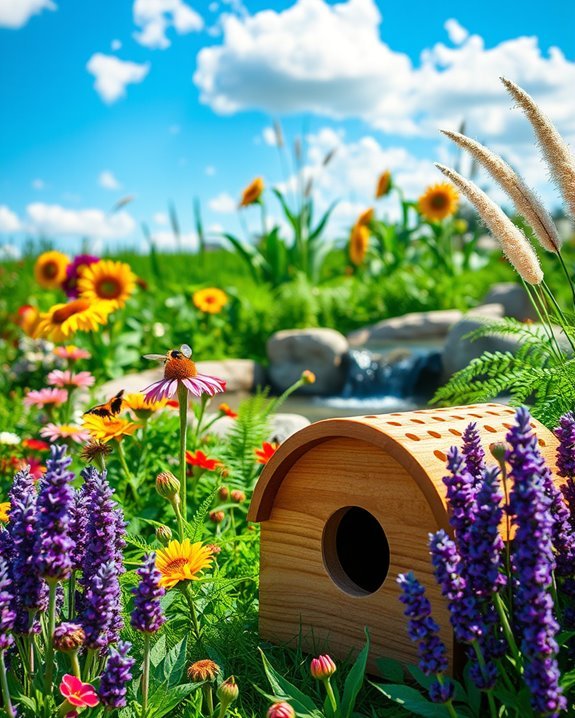
While many plants can beautify your garden, making it a pollinator-friendly space is essential for supporting bees, butterflies, and other beneficial insects.
Start by incorporating diverse pollinator plants like coneflowers, lavender, and milkweed into your garden design. Group these plants together to create vibrant patches that attract pollinators.
Avoid using pesticides, as they can harm these vital visitors. Additionally, consider adding water sources, like shallow dishes or birdbaths, to provide hydration.
Finally, leave some areas a bit wild with native grasses or wildflowers, creating a welcoming habitat for pollinators. Your garden will thrive with their help!
Use Gardening Kits for Beginners

After establishing a pollinator-friendly space, you might find that starting your gardening journey can feel overwhelming.
That’s where gardening kits come in handy! These kits typically include everything you need to get started—seeds, soil, and beginner tools. They simplify the process, allowing you to focus on the joy of planting and watching your garden grow.
Plus, many kits are designed specifically for beginners, ensuring you choose plants that thrive in your conditions. With a gardening kit, you won’t have to worry about selecting the right supplies; it’s all conveniently packaged for your ease.
Happy gardening!
Start With Perennials

Starting your garden journey with perennials can set you up for success, as these plants come back year after year with minimal effort on your part.
One of the greatest perennial benefits is their ability to thrive in various climates, making them suitable for any garden. From vibrant daylilies to classic hostas, there are countless perennial varieties to choose from.
They not only add beauty to your space but also attract beneficial pollinators.
As a beginner, focusing on perennials allows you to enjoy a flourishing garden with less maintenance, giving you more time to appreciate your hard work and creativity.
Use Companion Planting Techniques

Companion planting techniques can greatly enhance your gardening success by pairing plants that benefit each other. For instance, plant tomatoes alongside basil to improve flavor and deter pests.
You can also use crop rotation to keep soil healthy and prevent diseases. By alternating your plant families each season, you reduce the risk of pests and nutrient depletion.
Incorporate flowers like marigolds to attract beneficial insects for natural pest management. These strategies not only improve your garden’s health but also create a vibrant ecosystem.
Experiment with different pairings to discover what works best for your space and enjoy the rewards!
Grow Indoor Plants

In addition to outdoor gardening, growing indoor plants can bring life and freshness to your home.
Start by choosing low-maintenance varieties like pothos or snake plants, which thrive in various indoor lighting conditions.
Make sure to assess your space for natural light and consider using grow lights if needed.
For plant care, water your plants when the soil feels dry and use potting soil that drains well.
Dust the leaves occasionally to keep them clean and healthy.
With just a little attention, you can enjoy a vibrant indoor garden that enhances your living space and purifies the air.
Start a Compost Bin
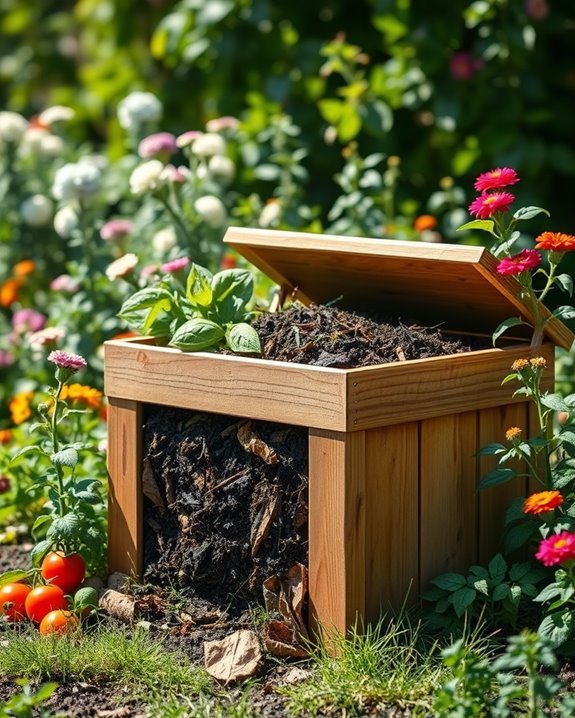
A compost bin can transform kitchen scraps and yard waste into nutrient-rich soil for your garden. You’ll enjoy compost benefits like improved soil structure and reduced waste.
Start with compost materials such as fruit peels, coffee grounds, and grass clippings. Choose compost methods that suit you, like the traditional pile or a worm bin for composting worms.
Don’t believe common composting myths, like needing to turn it daily; regular maintenance is enough. Keep your compost balanced with greens and browns, and watch it decompose into a black gold that enriches your plants, making your gardening experience even more rewarding.
Plant a Herb Spiral
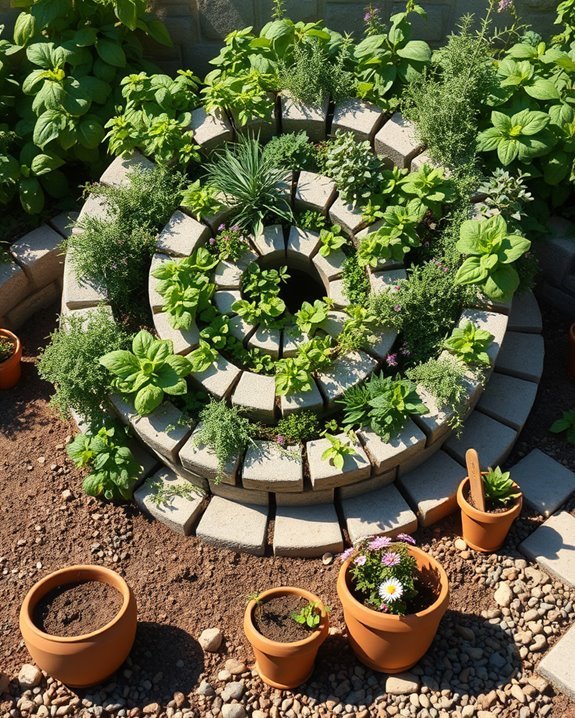
After you’ve set up your compost bin, consider planting a herb spiral to maximize your gardening space and enhance your culinary creations.
This creative herb spiral design allows for vertical herb planting, saving space while providing a variety of herbs. Start by creating a circular mound and gradually build it up, creating a spiral shape.
Plant herbs that thrive in different conditions, from sun-loving at the top to moisture-loving at the bottom.
Not only will you enjoy fresh herbs for cooking, but you’ll also create an eye-catching feature in your garden that’s both functional and beautiful.
Create a Fairy Garden

Creating a fairy garden can add a touch of magic to your outdoor space.
Start by choosing a spot and laying out magical pathways with pebbles or small stones. Incorporate a charming fairy house as the centerpiece and surround it with miniature plants for a lush feel.
Add whimsical decorations like garden gnomes and sparkling lights to bring your enchanted theme to life. Don’t forget tiny furniture for those playful creatures!
Use natural elements like twigs and leaves to blend everything seamlessly. With each detail, you’ll create a delightful haven that sparks imagination and joy for everyone who visits.
Try Hydroponics

If you’re looking for a different gardening approach, hydroponics offers an exciting way to grow plants without soil.
In hydroponic systems, plants thrive in nutrient solutions, allowing for faster growth and healthier yields. You can start with simple setups using containers and water, or invest in more advanced systems.
This method minimizes pests and diseases, and you’ll save space too! Choose your favorite herbs or leafy greens to get started.
Just remember to monitor the nutrient levels and pH regularly. Immerse yourself in hydroponics, and you’ll discover a rewarding and efficient way to cultivate your green thumb!
Use Seed Starting Trays
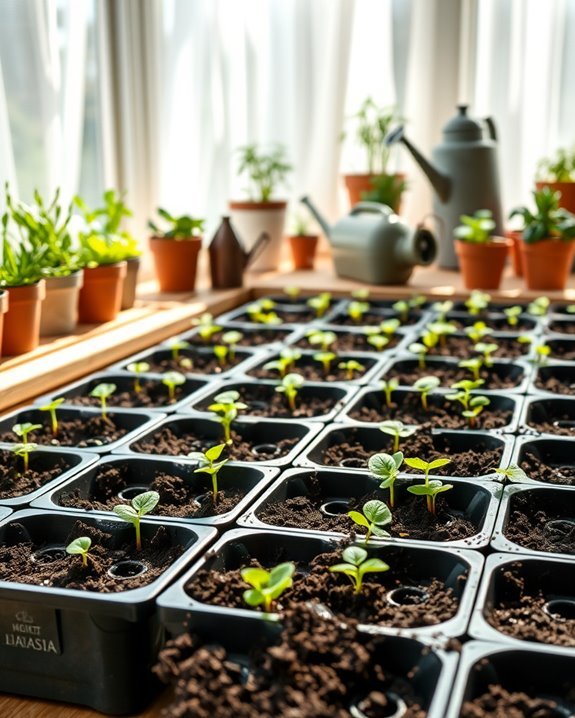
Using seed starting trays can be a game changer for your gardening journey, as they provide a controlled environment for germinating seeds.
These trays come in various tray materials like plastic or biodegradable options, allowing you to choose what works best for your needs.
Depending on the seed types you’re starting, you can select trays with different cell sizes, ensuring each seed has enough space to grow.
By using trays, you’ll make it easy to monitor moisture levels and provide consistent warmth, giving your seeds the best chance to sprout and thrive.
Immerse yourself in seed starting today!
Grow a Fruit Tree

After you’ve mastered seed starting trays, you might want to take your gardening skills to the next level by growing a fruit tree.
Start by choosing the right fruit tree varieties for your climate and space, like apple, peach, or citrus. Plant your tree in well-drained soil and make sure it gets plenty of sunlight.
Regular watering is vital, especially during dry spells. To keep your tree healthy, follow essential maintenance tips such as pruning, fertilizing, and protecting it from pests.
With patience and care, you’ll enjoy fresh fruits right from your garden, making your efforts truly rewarding!
Plant a Rainbow Garden
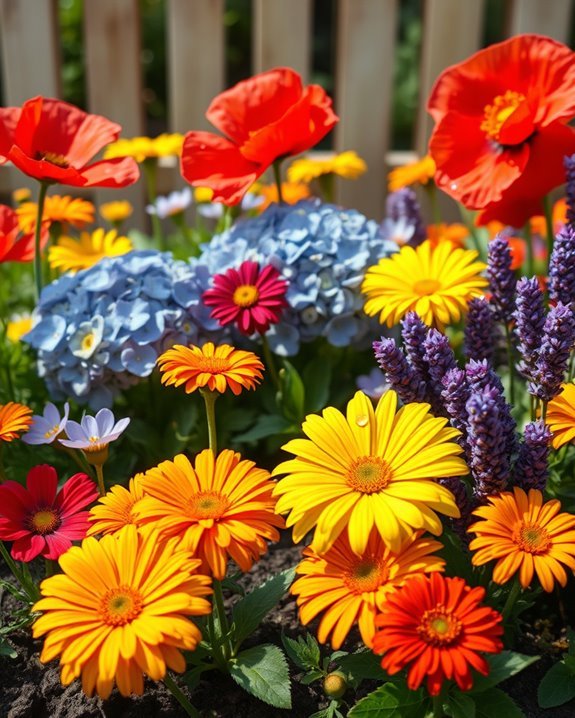
Creating a rainbow garden is a vibrant way to brighten up your outdoor space. Start by selecting colorful flower combinations that include reds, yellows, blues, and purples.
Think of planting cheerful marigolds, lovely lavender, and stunning sunflowers. Arrange your plants in a way that mimics a rainbow, shifting smoothly from one color to the next.
Don’t forget to include various heights and textures for added interest. By incorporating rainbow plant selections, you’ll create a lively atmosphere that attracts pollinators and delights your senses.
With a little planning, your garden will burst with color, making it a joyful retreat.
Use Edible Landscaping

When you blend beauty and functionality in your garden, edible landscaping becomes an appealing choice.
You can create a vibrant space by incorporating edible flowers like nasturtiums and pansies, which not only look stunning but also add flavor to your dishes.
Consider planting fruit shrubs, such as blueberries or raspberries, to provide delicious snacks right from your yard. These plants thrive while enhancing your landscape’s aesthetics.
By choosing a variety of colors and textures, you’ll enjoy a garden that’s both visually pleasing and practical.
Embrace edible landscaping, and watch your garden flourish with taste and beauty!
Start a Window Box Garden

If you’re looking for a way to grow your own food in a limited space, starting a window box garden might be the perfect solution.
Choose durable window box materials like wood, metal, or plastic to suit your style. Explore various window box designs, ensuring they fit your windowsill while providing proper drainage.
You can plant herbs, cherry tomatoes, or salad greens, making it easy to access fresh produce. Position your window box where it gets adequate sunlight, and remember to water regularly.
With a bit of creativity and care, you’ll enjoy a thriving garden right outside your window!
Use a Greenhouse

A greenhouse can transform your gardening experience, allowing you to grow a wider variety of plants in a controlled environment.
With its many greenhouse benefits, like extended growing seasons and protection from pests, you’ll see your plants thrive.
You can choose from various greenhouse types, such as freestanding, attached, or even mini greenhouses, depending on your space and needs.
Each type offers unique advantages, making it easier to maintain ideal temperatures and humidity levels.
Embracing a greenhouse means more successful gardening and enjoying fresh produce or blooming flowers year-round.
Try Straw Bale Gardening

While traditional gardening requires digging and soil preparation, straw bale gardening offers a unique and accessible alternative.
Start by choosing the right straw selection; clean, dry bales work best. For bale maintenance, soak them to initiate decomposition, which enriches the soil.
Use effective planting techniques by embedding seeds directly into the bales. Control moisture by monitoring the bales, ensuring they stay damp but not soggy.
Implement pest management strategies to protect your plants. Consider harvest timing and crop rotation for maximum yields.
Plan your garden layout according to climate considerations, maximizing sunlight and airflow. Enjoy a hassle-free gardening experience!
Grow Microgreens
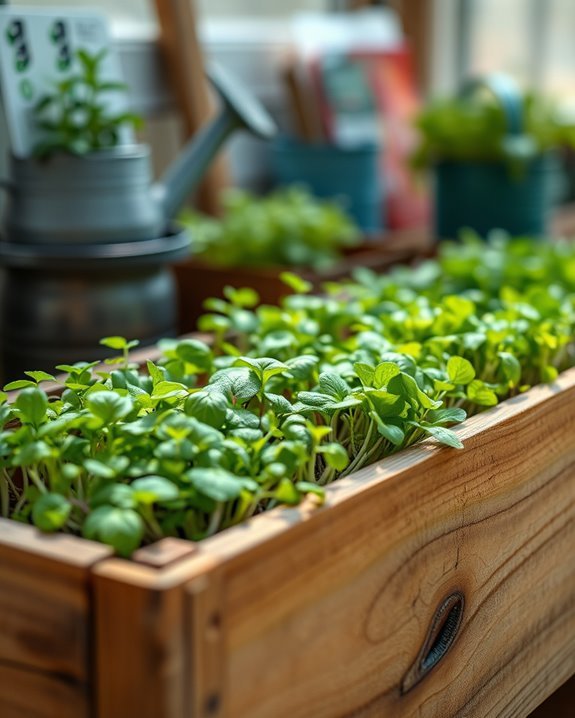
Growing microgreens can be a rewarding and straightforward way to kickstart your gardening journey, even if you have limited space.
These tiny greens pack a nutritional punch and come in various microgreen varieties, including radish, basil, and broccoli.
To get started, choose a shallow tray, fill it with potting soil, and sprinkle your seeds evenly.
Water them gently and place them in a sunny spot.
Use simple growing techniques like keeping the soil moist and providing good airflow.
Within a week, you’ll have fresh, flavorful greens to enjoy in salads, sandwiches, or smoothies.
Happy gardening!
Incorporate Aromatic Plants

Incorporating aromatic plants into your garden not only enhances the beauty of your space but also adds delightful scents and flavors to your cooking.
Consider planting fragrant herbs like basil, rosemary, and mint; they’re easy to grow and perfect for seasoning dishes. You can also add aromatic flowers such as lavender and chamomile, which not only smell amazing but attract beneficial pollinators, too.
These plants thrive in various conditions, so you can find the perfect spot for them. With a mix of fragrant herbs and aromatic flowers, your garden will be a sensory delight that elevates your culinary experiences.
Create a Sensory Garden

Aromatic plants can be a fantastic starting point for creating a sensory garden that fully engages your senses. Incorporate scented flowers and fragrant herbs to fill the air with delightful aromas.
Add colorful blooms for visual appeal and textured foliage to create tactile elements for touch. Design sensory pathways with various materials to enhance the experience.
Include sound features, like wind chimes or rustling grasses, to engage your hearing. Finally, consider taste plants, such as edible flowers or herbs, to delight your palate.
Start a Vegetable Patch

If you’ve ever dreamed of plucking fresh tomatoes or crisp lettuce straight from your garden, starting a vegetable patch is the perfect way to make that dream a reality.
Begin by choosing easy-to-grow vegetable varieties like radishes, carrots, or zucchini. These are forgiving for beginners and yield quickly.
When planting, remember to space your seeds properly and follow the recommended depth for each type. Keep your patch well-watered, but avoid over-watering to prevent root rot.
Incorporate organic compost for healthy soil. With these planting tips, you’ll soon enjoy the fruits of your labor right from your backyard!
Use Raised Planters
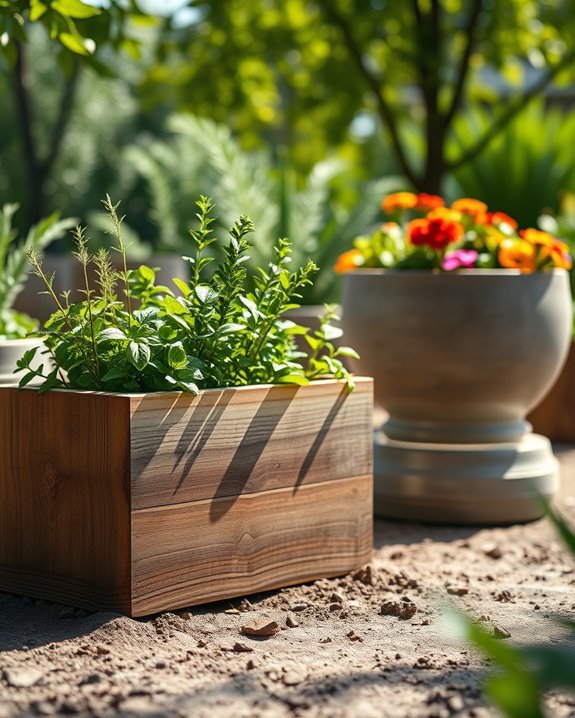
For those who want to take their gardening to the next level, raised planters can be a fantastic option. They offer numerous raised planter benefits, such as improved drainage, better soil quality, and easier access for planting and maintenance.
You can choose from various raised planter designs, including wooden boxes, metal containers, or even tiered structures that add visual interest to your garden space. These planters also help keep pests away while minimizing back strain during gardening.
Grow a Zen Garden

Creating a Zen garden can be a rewarding way to cultivate tranquility in your outdoor space.
Start with zen garden essentials like raked gravel, which symbolizes water, and carefully placed stones for balance. Choose a few plants—think low-maintenance options like succulents or bamboo—to add life without overwhelming the senses.
Incorporate elements like a small fountain or a bench for relaxation. Your tranquility garden design should promote calmness, so keep it simple and uncluttered.
Spend time tending to it, and you’ll find your Zen garden becomes a peaceful retreat, perfect for reflection and mindfulness in your everyday life.
Create a Wildlife Habitat

Building a wildlife habitat in your garden not only supports local ecosystems but also brings joy as you observe various creatures thriving in your space.
Start by selecting wildlife friendly plants that provide food and shelter for birds, butterflies, and bees. Incorporate a mix of native flowers, shrubs, and trees to attract diverse species.
To create nesting sites, consider adding birdhouses, bee hotels, or even leaving some areas of your garden wild.
Plant a Themed Garden

While designing your garden, consider planting a themed garden to add a unique touch that reflects your personality and interests. You can draw theme inspiration from your favorite colors, hobbies, or even culinary tastes.
For instance, a butterfly garden filled with nectar-rich flowers will attract beautiful pollinators, while a herb garden can spice up your cooking. Think about how you want to enjoy your space and let that guide your garden design.
Group plants with similar themes together for a cohesive look, and don’t forget to incorporate decorative elements like sculptures or pathways to enhance your theme even further.
Use Garden Markers
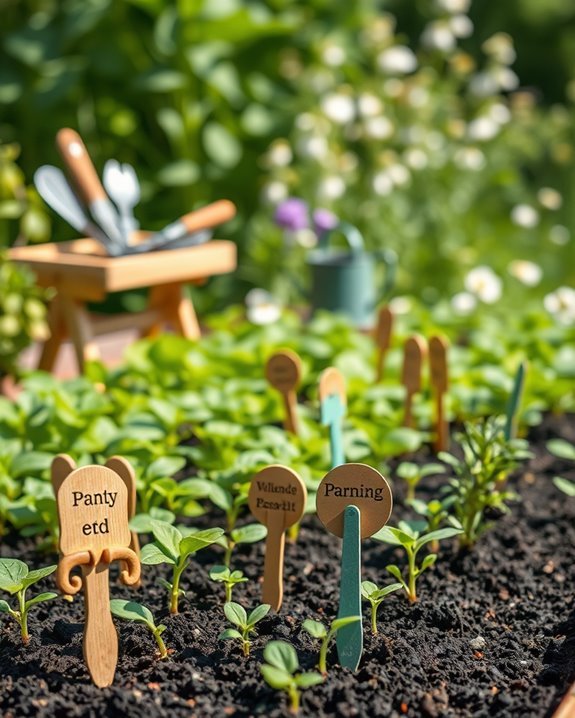
Using garden markers can greatly enhance your gardening experience, especially when you’re growing a variety of plants. These markers help you keep track of what’s planted where.
You have plenty of garden marker options, from wooden stakes to colorful plastic tags. Consider using creative labeling techniques like writing plant names with permanent markers or adding little drawings for a personal touch.
This not only makes your garden look organized but also adds a splash of creativity. Plus, it saves you time when you’re planning your care routine.
Start a Community Garden

Starting a community garden can be a rewarding way to connect with your neighbors and cultivate fresh produce together.
You’ll foster community involvement while learning from one another. Gather interested locals and find a suitable plot of land, whether it’s a vacant lot or a public park.
Organize gardening workshops to share tips and techniques, making it a fun learning experience for all. Encourage everyone to pitch in, whether they’re seasoned gardeners or complete beginners.
With teamwork and shared goals, you’ll not only grow delicious fruits and vegetables, but also strengthen relationships within your community.
Happy gardening!
Grow Climbing Plants
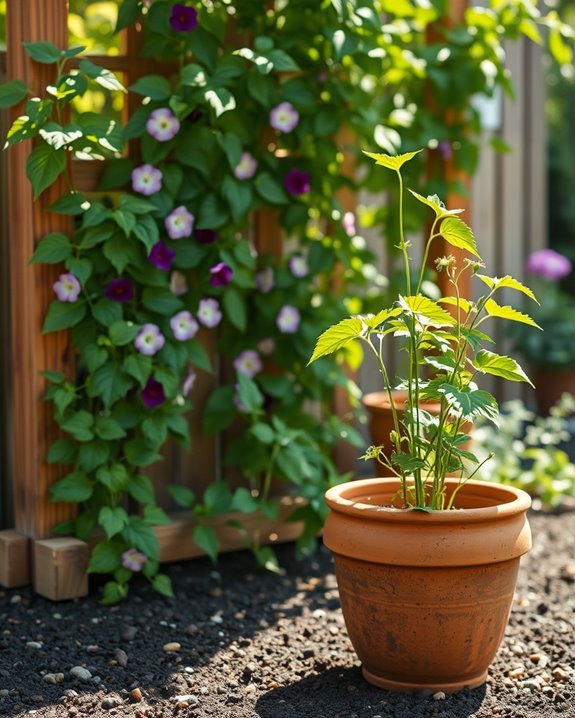
Climbing plants can transform your garden by adding vertical interest and maximizing space. To get started, choose varieties like beans, peas, or flowering vines that suit your climate.
Set up climbing structures, such as trellises or arbors, to provide sturdy vine support. Position these structures in sunny spots, as most climbing plants thrive in bright light.
Regularly check for growth, ensuring the plants are securely attached to their supports. Water them consistently and watch as they climb, creating a lush green backdrop or colorful display.
With a little care, you’ll enjoy the beauty and functionality of climbing plants in no time!
Use Mulch for Weed Control

With your climbing plants thriving, it’s time to think about maintaining a tidy garden.
One effective way to manage weeds is by using mulch. There are various mulch types, like wood chips, straw, and shredded leaves, each offering unique benefits. By applying a thick layer of mulch around your plants, you’ll suppress weed growth and retain moisture in the soil.
This not only simplifies your weed management but also enhances the overall health of your garden. Remember to refresh the mulch periodically to keep it effective.
A little effort now will save you time and frustration later!
Experiment With Plant Propagation
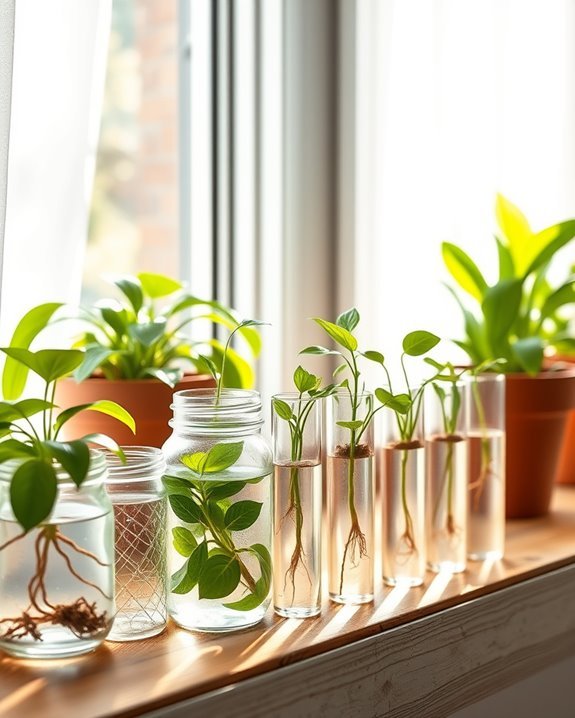
Plant propagation is a fun and rewarding way to expand your garden without breaking the bank.
By experimenting with various propagation techniques, you can multiply your favorite plants easily. Start with plant cuttings, which involve snipping a healthy section of the plant and encouraging it to root in water or soil.
You can also try division or layering, depending on the type of plant. It’s exciting to watch new growth emerge from your efforts.
Don’t be afraid to test different methods and see what works best for you. Soon, you’ll have a thriving collection of plants to enjoy!
Create a Seasonal Flower Bed

After you’ve had fun experimenting with plant propagation, why not take your gardening skills a step further by creating a seasonal flower bed?
Start by choosing a variety of flowers that showcase vibrant seasonal colors. Think about spring blooms like tulips and daffodils, followed by summer favorites like sunflowers and zinnias. For fall, consider chrysanthemums and asters.
When making your flower selection, make sure you mix heights and textures for visual interest. Arrange your flowers in groups to create a stunning display.
With a little planning, you’ll have a beautiful flower bed that changes with the seasons, delighting you all year round!
Learn Basic Garden Maintenance Techniques
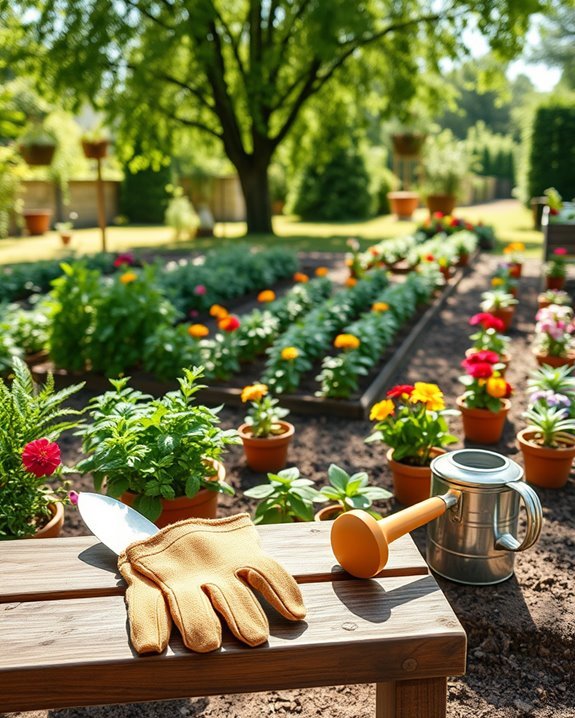
Maintaining a garden doesn’t have to be overwhelming; in fact, a few basic techniques can keep your plants healthy and thriving.
Start by focusing on soil health—healthy soil provides essential nutrients. Test your soil regularly and amend it with compost or organic matter as needed.
Next, master effective watering techniques. Water deeply but infrequently, allowing the soil to dry between sessions. Early mornings are ideal for watering, reducing evaporation and fungal diseases.
Keep an eye on your plants for signs of stress or pests. With these simple maintenance practices, you’ll enjoy a flourishing garden that brings you joy.
Conclusion
Gardening can be your canvas, where each plant is a stroke of creativity waiting to bloom. As you immerse yourself in these beginner-friendly ideas, remember to enjoy the journey—every seed you plant is a step toward your own green masterpiece. Embrace the joy of nurturing life and watching your garden flourish. With patience and a little care, you’ll cultivate not just plants, but a rewarding hobby that brings beauty and tranquility to your space. Happy gardening!

